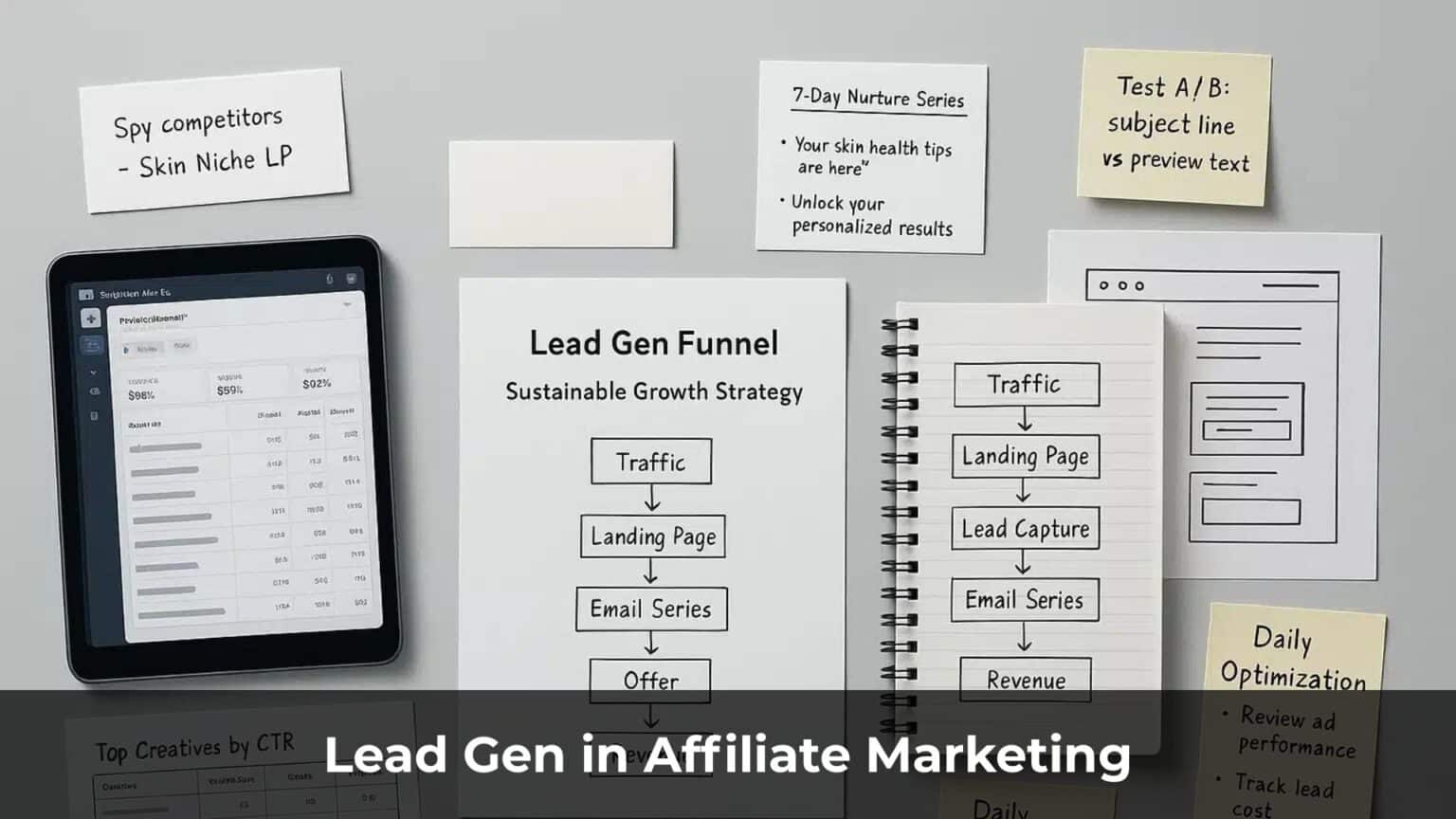Affiliate marketing is like a competitive sport.
You’re not just running your own race—you’re up against thousands of others, fighting for the same traffic, the same offers, and ultimately, the same conversions.
And just like in sports, the landscape keeps shifting.
New trends pop up all the time.
Some look like golden opportunities.
Others? Minefields of intense competition and razor-thin margins.
In this post, I’ll walk you through how affiliate trends evolve—what’s changing, why it matters, and how you can spot these shifts early.
The better you understand the direction the market is heading, the better you can prepare, adapt, and stay profitable.
Table of Contents
ToggleTwo Common Approaches to Affiliate Marketing
From what I’ve seen, most people who get into affiliate marketing tend to fall into one of two categories.
While everyone has their own unique strategy,
these two general approaches show up again and again—and understanding the difference between them can help you decide which path fits you best.

The Evergreen Affiliate
The first group is what I call the Evergreen Affiliates — marketers who stay rooted in one niche for years.
These are the folks who found their niche early and stuck with it long-term. If they were promoting adult dating offers back in 2015, chances are they were still running campaigns in that same vertical by 2025.
Just imagine the depth of insight they gain after 10 years in the same market. They know the traffic sources inside out. They understand the psychology of the audience. They’ve refined their angles, funnels, and tracking setups to the smallest detail.
Evergreen affiliates don’t chase trends. They find what works—and double down on it.
If you want to be in this group, you need to build long-term competitive advantages. That means choosing a vertical, understanding it deeply, and creating systems that make you irreplaceable.
Let’s say you decide to specialize in the education niche. You could start by promoting education lead-gen offers. Over time, you build your edge by collecting your own leads and selling them directly to advertisers.
That’s the power of focus.
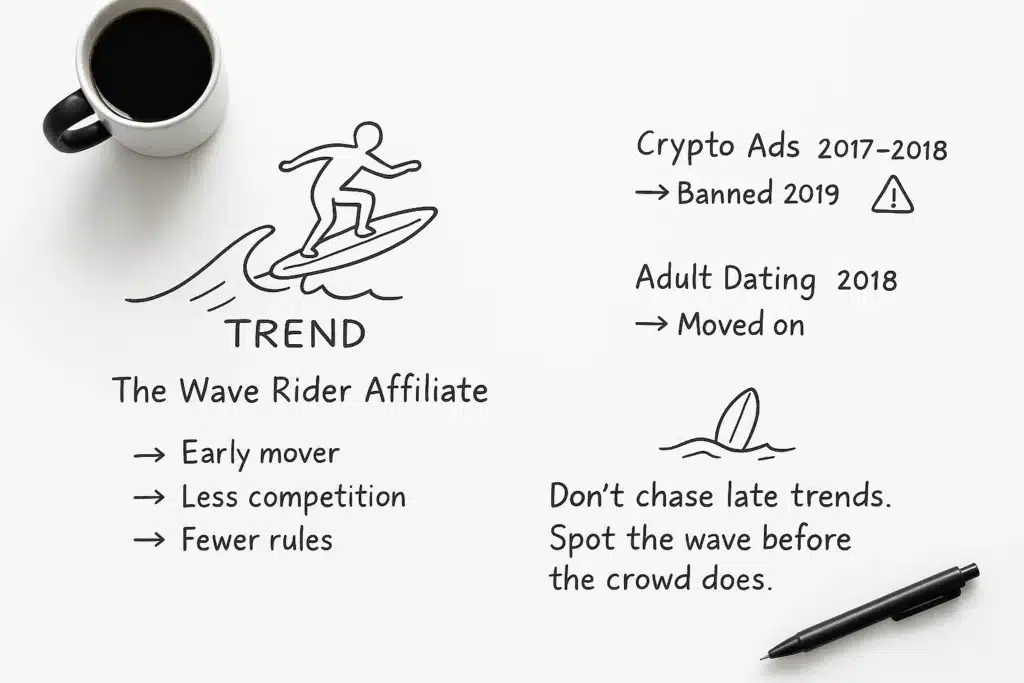
The Trend-Riding Affiliate
The second type of affiliate marketer? I call them the Wave Riders.
These are seasoned marketers who stay sharp and flexible—constantly surfing the latest trends.
They’re like pro surfers watching the ocean. They sit back, observe the waters, and when they spot a promising wave, they paddle hard, find the perfect position, and ride it with precision.
Why do they chase trends year after year?
Because there’s power in being early. The newer the market, the less competition you face.
Sometimes there are fewer restrictions too. For example, early crypto affiliates ran Facebook Ads freely—until Facebook eventually banned those ads. The advantage came from getting in before the rules changed.
Trend-riders either take advantage of market freshness, or they simply enjoy trying new things. I used to run adult dating offers heavily back in 2018—but now? I’ve completely moved on.
It’s not even about how much money it makes. I just got bored—and that’s okay.
If you want to follow this path, you need to stay on top of what’s trending and, more importantly, understand why it’s trending.
Because if you don’t, you’ll only spot the trend when it’s already saturated—and by then, the real money’s gone.
Why Do Affiliate Trends Keep Changing?
I’ve been in this industry since 2017, and if there’s one thing I’ve learned, it’s this: affiliate marketing never stays still.
Trends rise. Trends crash. Some niches explode overnight—others quietly fade away.
But why does this happen?
There are several reasons why affiliate marketing trends are in constant motion. In this section, we’ll break down the key forces that shape the rise and fall of what’s hot in the affiliate world.
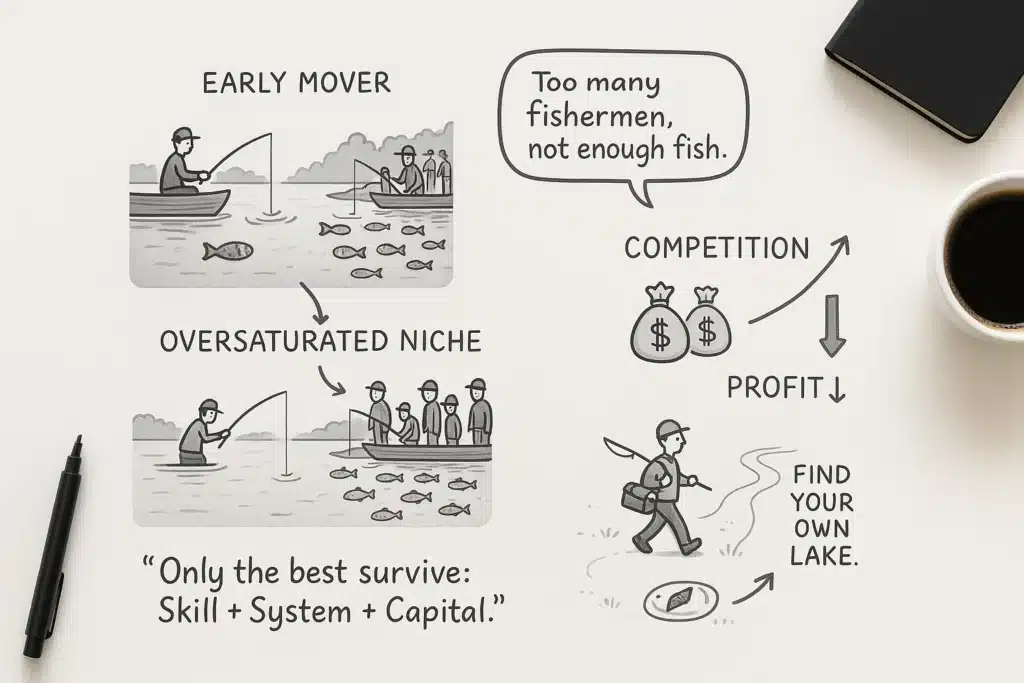
1. Oversaturation – Too Many Fishermen, Not Enough Fish
Imagine you’re a fisherman. One day, you stumble upon a quiet lake full of fish. Every time you cast your line, you pull in a fresh catch. Life is good.
But word gets out. People notice you always returning with a basket full of fish. Others get curious. Soon, more fishermen start showing up at the same lake. They tell their friends, and it snowballs from there.
A few months later, the lake is crowded. The fish population starts to drop. Suddenly, your once-reliable spot isn’t producing much anymore.
This is exactly what happens with many affiliate niches and traffic sources. Maybe the traffic pool was never that big to begin with. Maybe the rising competition pushes up ad bids. Either way, it becomes harder and harder to make a profit.
What happens next?
Only the best fishermen survive—the ones with skill, systems, and deep pockets. Everyone else? They’re forced to move on and find a new lake.
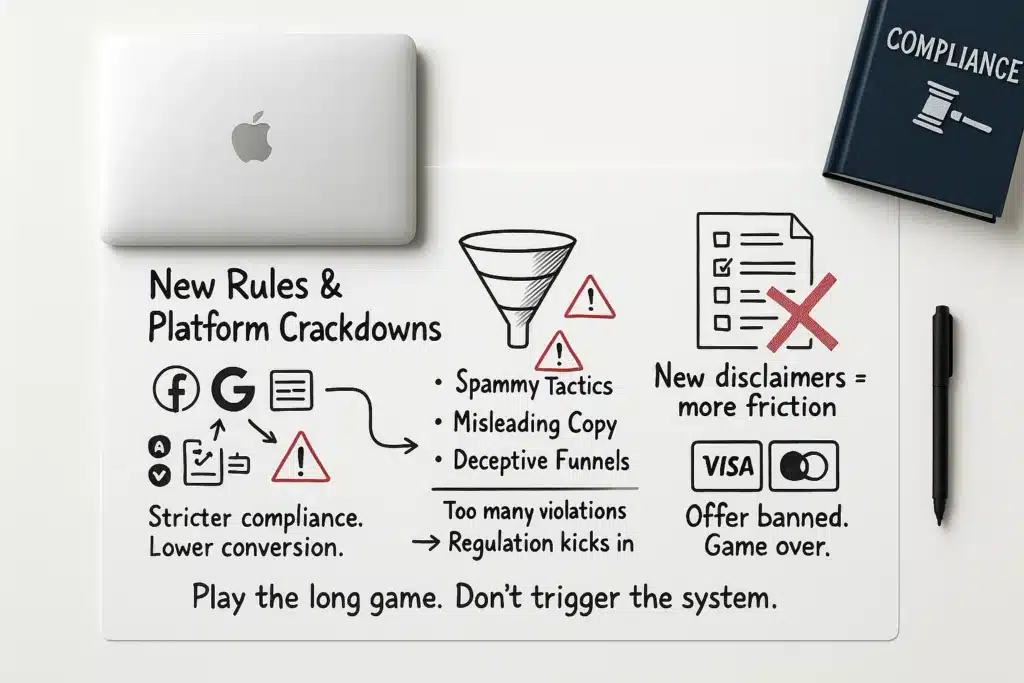
2. New Rules and Regulations
Sometimes, it’s tough to get conversions—so affiliates go aggressive. They push hard with spammy tactics, misleading copy, or borderline deceptive funnels.
And when enough affiliates cross the line, legal trouble starts brewing—lawsuits, regulatory scrutiny, or customer complaints pile up.
In response, traffic sources tighten the rules. New ad policies get rolled out. Platforms like Facebook, Google, and native networks start enforcing stricter compliance standards.
It’s not just the platforms. Advertisers change too. Back when mobile offers were booming, many didn’t bother listing proper terms and conditions. But once new regulations came in, they had to add extra disclaimers and multiple checkbox confirmations—resulting in lower conversion rates.
Or maybe the offer you’re promoting is considered misleading. Suddenly, Visa and Mastercard stop processing payments for that vertical. Game over.
3. New Markets Are Emerging
About 15 years ago, affiliate marketers mostly focused on the “Big Four”: the U.S., Canada, the U.K., and Australia.
But today, affiliates are making money in countries all over the world.
I still remember when Cash on Delivery (COD) started gaining traction a few years ago. In many countries, people didn’t use credit cards regularly.
So when COD became an option—letting customers pay only after the product arrived at their doorstep—it spread like wildfire.
A small change like that opened up entirely new markets almost overnight.
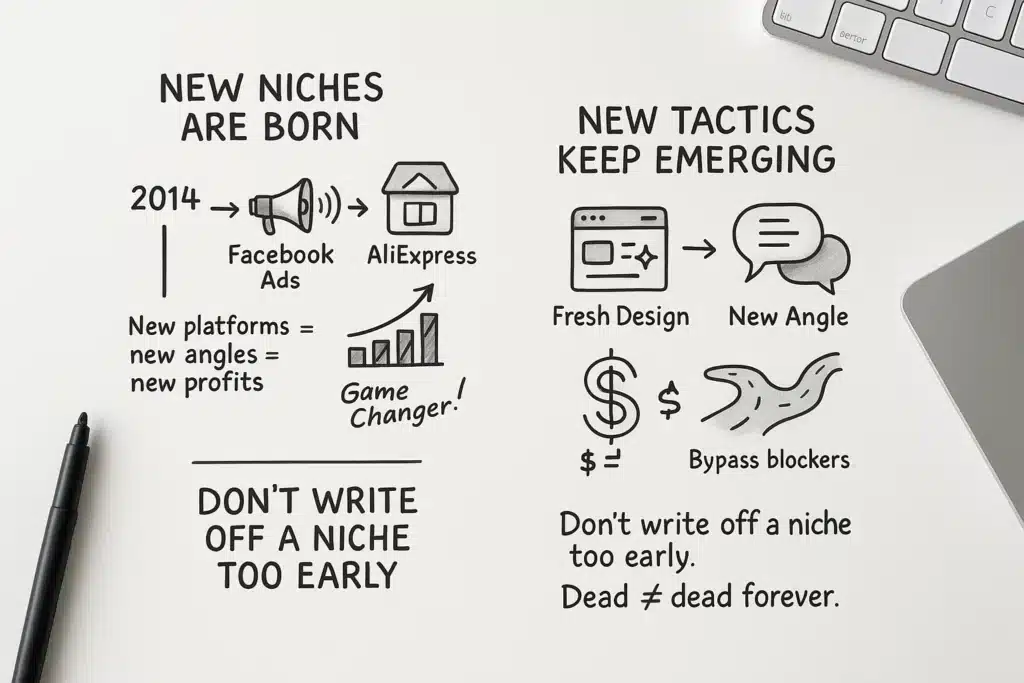
4. New Niches Are Born
About a decade ago, the Shopify and dropshipping model was virtually unheard of in affiliate marketing.
Then suddenly, a wave of momentum hit—driven by Facebook Ads, Shopify stores, and AliExpress suppliers. It was a game-changer.
Why? Because affiliates could now promote almost anything they wanted, from quirky gadgets to trending lifestyle products—without triggering Facebook’s ad review system (at least, back then).
A brand-new niche had emerged. And with it came new offers, fresh angles, and a flood of opportunity.
This is how affiliate marketing keeps evolving. Every time a new platform, business model, or tech shift happens, new niches are created—and those who spot them early often make the most profit.
5. New Tactics Keep Emerging
Affiliate marketing is a fast-moving game. New tactics are constantly being developed, tested, and shared.
This is both a blessing and a curse.
I’ve seen entire niches that were considered “dead” come roaring back to life—sometimes in just a few months—because someone discovered a new way to approach them.
It could be a fresh landing page design, a new angle that resonates better with the audience, or a creative promotional strategy that bypasses previous blockers.
The lesson? Don’t be too quick to write off a niche just because no one is running it right now.
Sometimes, all it takes is one clever innovation—and that “dead” niche becomes profitable again, just like it used to be.
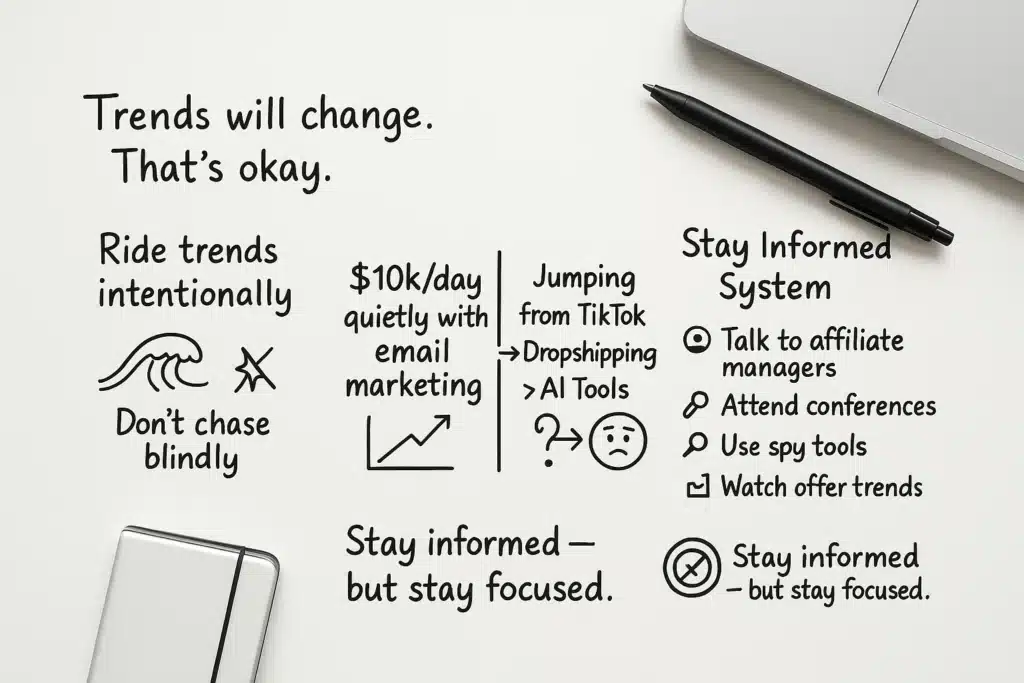
Trends Will Always Change — And That’s Okay
Trends come and go. That’s the nature of affiliate marketing. But just because something isn’t trending doesn’t mean it can’t make money.
You probably won’t see “email marketing” making headlines on affiliate forums—but I can guarantee there are still marketers quietly pulling in $10k a day with it.
Here’s the key: riding trends is not the same as chasing shiny objects.
Experienced affiliates who ride the waves do it with intention. They have the skills, the data, the research, and the systems to make it work. They’re not just hopping on a bandwagon because it “sounds interesting.”
So don’t rush. Don’t switch strategies every few weeks. Choose the right path—and stick to it long enough to see real results.
At the same time, build a system for spotting and understanding new trends quickly. Talk to your affiliate managers. Attend industry conferences. Use spy tools. Monitor offers on different networks.
Stay informed—but stay focused.
Final Thoughts: Play Your Own Game
In affiliate marketing, there’s no one-size-fits-all path.
Some succeed by going deep into one niche for years. Others thrive by moving fast and riding trends. Both approaches work—if done right.
The key is to know yourself. Are you the kind of person who wants to build long-term systems? Or do you enjoy exploring new opportunities and adapting quickly?
Whichever path you choose, commit to it. Master the fundamentals. Build real skills. And stay curious about how the game is evolving.
Because while trends may change, the people who understand why they change will always be one step ahead.





